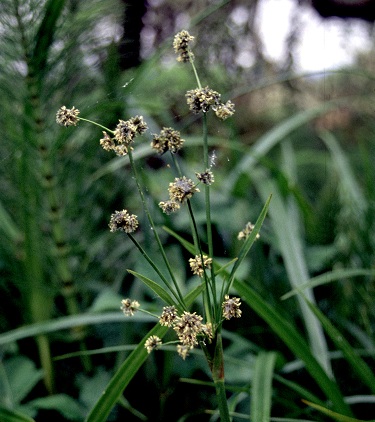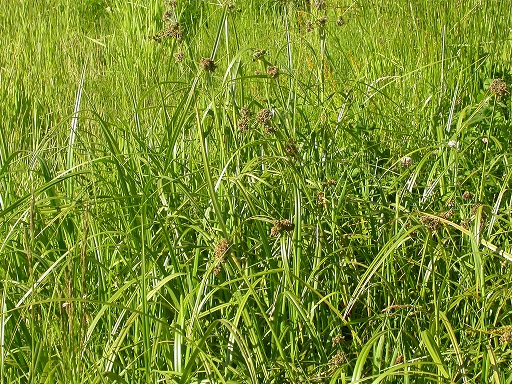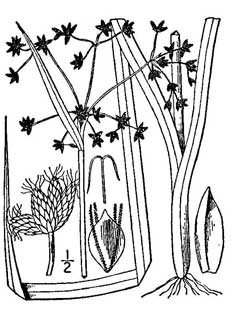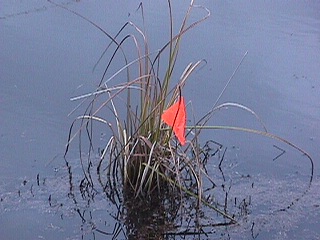|
|
|
Hansen's Northwest Native Plant Database |
|
|
Scirpus microcarpus also known as S. sylvaticus and S. rubroticus (Small-Flowered Bulrush, Small-Fruited Bulrush, Panicled Bulrush, Mountain Bog Bulrush, Redstem Bulrush)
|
 |
||||||||||||||||||||||||||||||
|
Plant Brief:
Small-Fruited Bulrush is a vigorous grower in sloughs, streambanks, and disturbed sites such as
ditches and wet clearings. This species likes to be wet
year-round, although the soil may be dry at the surface during
drought. It may tolerate some shade, but will grow less
vigorously. Provides valuable food and nesting material for
wildlife. Photo above from A Photographic Guide to Plants of Humboldt Bay Dunes and Wetlands Compiled by Gordon Leppig & Andrea J. Pickart, Release 1.0, January 2005 |
|||||||||||||||||||||||||||||||
 Photo by Matt Levinn, http://www.flickr.com/photos/plant_diversity/4155809216 |
Description: The Small-Flowered
Bulrush is a stout
plant with triangular stems, growing to heights of 4 ½.’ Multiple stems
emerge from each plump rhizome. The rhizomes are oblong and have thick,
rough skins, resembling arrowroot. Many leaves, in sets of three, branch from both the base and the stems. The leaves are extremely sharp (indeed the plant was called “Cut-grass” by some First Nations groups) and have a marked crease down the centre. The leaf sheaths have a distinct purple or red hue (hence the alternate common name ‘Redstem Bulrush’). From the tip of the stem, 2” long clusters of flowers extend upwards. |
||||||||||||||||||||||||||||||
|
Habitat and Geographic Range: Small-Flowered Bulrush occurs from low to middle elevations in USDA zones 2 – 6B. It grows in freshwater wetlands only. While it is common in the Pacific northwest, it is considered an endangered species in Kentucky and New Jersey and is protected by law in those states. Uses of Plant--Ornamental Value: Admittedly, the flowers of all sedges are not showy: the petals lack both bright colours and intricate forms. However, they are extremely unique in their form and their blooming cycle is remarkably long – from April to September. Moreover, the plant itself provides colour all year, never turning brown even in the driest spells. |
|||||||||||||||||||||||||||||||
|
Native
Plant Gardening/Wildlife Habitat:
Small-Flowered Bulrush
provides excellent habitat for many wildlife species. Birds of all types
frequent and depend upon stands of Small-flowered bulrush. Small animals
such as turtles, muskrats, snakes, and amphibians seek refuge in the
dense growth of this plant. Propagation: Small-Flowered Bulrush should be planted 1-2" into moist to wet soil. This species does not tolerate long periods of flooding. Wetland plants are best planted in the fall, at the beginning of the rainy season and preferably before frost. It can take a plant up to two weeks to recover from the shock of transplanting. If given a brief period of rain, they will have a healthy start before frost hits and then the winter dormant cycle gives them time in which to develop a healthy root system. |
 |
||||||||||||||||||||||||||||||
|
Historical and Special interest: First Nations people, most notably the Okanagan, used the Small-Flowered Bulrush for weaving berry baskets. It was also used as a decorative addition to clothing. When steaming foods in a fire, the leaves were sometimes laid under and on top of the food. Most interestingly, the sharp leaves of the Small-flowered bulrush were even used as cutting implements, although they were not highly efficient. Small-Flowered Bulrush is also edible. The rhizomes can be eaten raw, cooked or dried and ground into flour. The pollen and seeds can be gathered and added to baked goods.
See the King County, Washington plan for a bioretention
facility/rain garden:
http://www.kingcounty.gov/transportation/kcdot/Roads/Environment/LowImpactDevelopment_MilitaryRd/Plants.aspx
Good info on using native wetlanders. The project outlined here was for 2000, but the report is down-to-earth and suitable for adaptation to a home landscape area. Here's how they used for our Scirpus microcarpus (and Carex spp. Scirpus): |
|||||||||||||||||||||||||||||||
http://depts.washington.edu/ehuf572/reports/2001/group1/index.htm This little one sort of reminds me of Charlie Brown's Christmas tree, but it has been given the gift of happy natural life. |
 |
||||||||||||||||||||||||||||||
|
|||||||||||||||||||||||||||||||
|